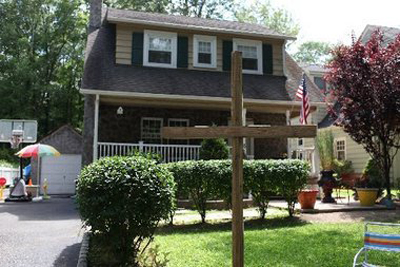
(RNS-AUG05) A wooden cross sits outside the home of Patrick Racaniello, resident of Livingston, NJ. For use with RNS-CHURCH-FIGHT. Transmitted August 05, 2011. Courtesy the Star-Ledger.
LIVINGSTON, N.J. (RNS) It started as a simple gesture.
But it could have implications far beyond the quiet New Jersey street where Patrick Racaniello affixed a wooden cross on a tree in his front yard.
Livingston Township officials say Racaniello’s display, which he intended as a celebration of Lent, violated an ordinance that generally prohibits postings on a structure, including a tree, “calculated to attract the attention of the public.”
Advised of the ordinance, Racaniello removed the cross. But he then built a second, much larger cross that he planted on his property just within the township’s 10-foot right of way. Racaniello, again facing fines, took down that cross, too.
He also contacted the Arizona-based Alliance Defense Fund, a coalition of conservative Christian lawyers. The alliance told the township it may take the matter to court if officials don’t allow Racaniello to put the cross wherever he wants on his property.
“We believe this is private property, and therefore he has a right to engage in this expression,” Jonathan Scruggs, a lawyer for the alliance, said in an interview. “We believe that either cross is protected by the First Amendment.”
The judicial outcome of this conflict between an Essex County town and an Arizona legal group, scholars say, could go a long way to determine the reach of a 2000 federal land-use law intended to protect religious expression.
Racaniello, whom neighbors described as an entrepreneur, declined to answer questions, and referred all inquiries to ADF.
Scruggs said he would wait for the township’s written response before the alliance decides whether to proceed with litigation.
Township attorney Sharon L. Weiner said the town is enforcing its right of way for the public good.
“It is a distraction to the traveling public,” she said of the cross and other postings in the 10-foot buffer.
The town will yield one point to Racaniello. She said the town council will tweak its code to allow residents to fasten a cross on a tree on property not within the right of way.
Weiner emphasized the township was not singling out Racaniello or his display.
“We’re very sensitive to his First Amendment rights,” she said.
Charles C. Haynes, a First Amendment scholar, said a federal law enacted by Congress a decade ago could trump the township’s regulations. In part, the Religious Land Use and Institutionalized Persons Act of 2000 says government entities cannot impose a land-use regulation that burdens a person’s free exercise of religion unless there is “a compelling governmental interest.” That regulation must also be the least restrictive to religious practice, the act says.
The burden of proof, in other words, could fall on Livingston, said Haynes, a senior scholar at the nonpartisan First Amendment Center.
“Under current law, I think this guy has a pretty strong case,” said Haynes, also the director of the Religious Freedom Education Project at the Washington, D.C.-based Newseum. “I’m not sure what the township thinks is a problem. … It might mean that the town has a problem.”
Because the tree is on Racaniello’s property, the town’s interest could be particularly difficult to establish, Haynes said.
Should the matter go to court, Haynes said, a ruling would help determine the federal law’s reach.
A New York-based constitutional lawyer, Akiva Shapiro, said a court case would likely focus on the township’s application of its ordinances apart from this instance.
“At first blush, if somebody had a decorative lawn ornament in their front yard, and those were not targeted, that might suggest some discriminatory application,” said Shapiro, who has argued a number of religious freedom cases.
Shapiro, though, said any litigation could also hinge on the First Amendment. “Putting up the cross is an expressive activity,” he said, that often finds favor with the courts.
The law passed in 2000, Shapiro said, was meant to ensure those activities were given added protection, which could work in Racaniello’s favor. The religious land use act “was passed because Congress wished to give a cushion beyond the First Amendment to religious activity,” he said.
But Weiner, a former town council member and a land-use attorney in her private practice, said the township reviewed case law tied to the act, and was skeptical it could be applied successfully in this case.
“That deals with land-use regulations,” Weiner said of the act. It would not apply in this instance since the township is not keeping organized religious activity, such as the construction of a church, from taking place, she said.
Weiner, who is preparing a written response to Scruggs’ letter, said township officials were disturbed and frustrated at the alliance’s apparent effort to make the issue a test case. In doing so, alliance attorneys are unjustly painting the township as intolerant, she said.
“They’re making it out that, because it’s a cross, we’re not allowing it. That’s not so. It’s a content-neutral regulation,” Weiner said. “I’m afraid they’re going to make this a cause celebre.”
(Richard Khavkine writes for The Star-Ledger in Newark, N.J.)




